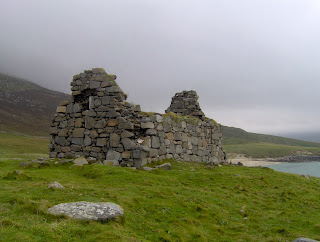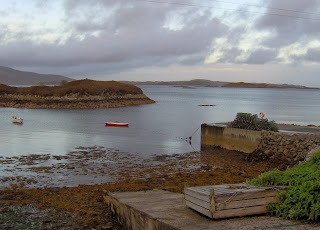The Man who gave away his Island: A Life of John Lorne Campbell of Canna by Ray Perman - first published in 2010
I should read more biographies, as so often they are illuminating, informative and inspiring and this one is no exception. John Lorne Campbell was born into a Scottish landowning family in 1906. On the surface they were wealthy and John was educated at Rugby School and Oxford University. However in John's lifetime his family's houses and estates in Scotland had to be sold off to repay the debts passed on by previous generations. John developed an interest in Gaelic history, culture and language and in 1933 he travelled to Barra, where he became friends with the author Compton Mackenzie. He met his future wife Margaret Fay Shaw on South Uist in 1934. She was an American by birth but she was also interested in Gaelic culture and music. They married in 1935 and in 1938 John borrowed heavily in order to buy the island of Canna. He spent the next 43 years struggling to make an economic success of the island. He persevered despite various setbacks, including a World War, various staffing problems and a mental breakdown. He also found the time to write and collect numerous books about Gaelic culture, to make recordings of native Gaelic speakers in order to preserve a fast vanishing language and musical heritage and to campaign for better services for the people of the Hebrides e.g. improve ferries.
John and Margaret had no children and John decided the best way to secure Canna's long term future was to give it to the National Trust for Scotland, which he did in 1981. He didn't always agree with the NTS about how to run the island but he and Margaret continued to live on Canna until their deaths in 1996 and 2004 respectively. John died while on holiday in Italy and was initially buried there but 10 years later his remains were exhumed and he was re-interred on Canna in the small birch wood that he had planted behind the Catholic chapel.
This is a sympathetic portrait of a naturally shy man who cared passionately about improving the lives of the inhabitants of the Hebrides and in preserving their Gaelic cultural history and traditions.
Sadly Canna doesn't seem to have prospered in the last few years for various reasons and in 2012 the population fell to 8. As Ray Perman says "When he gave Canna to the nation John Lorne Campbell was aware that he was passing on a burden, as well as a treasure. He had devoted his life to it and the cost, both in the money he ploughed into it and the proceeds forgone, meant nothing to him." He also quotes Winnie MacKinnon, a long term resident of Canna, referring to the high turnover rate of new residents on Canna "They come here to get away from everything, but what they need is to get away from themselves. This happens time after time." I also like the quote from The Gaelic Poems of Father Allan MacDonald (transcribed and published by John Lorne Campbell in 1965) given at the top of the chapter about John's death: "The time or place of our death doesn't matter, Since happiness doesn't need a funeral."
9/10
Islands covered - Canna, Rum, Eigg, Muck, South Uist, Barra, Eriskay and Mingulay
Canna - looking towards the Church and ferry terminal
Canna House - John and Margaret's home
Escallonia Tunnel at the entrance to Canna House
Looking south towards Rum
John Lorne Campbell's grave on Canna
North Coast of Canna from Compass Hill










